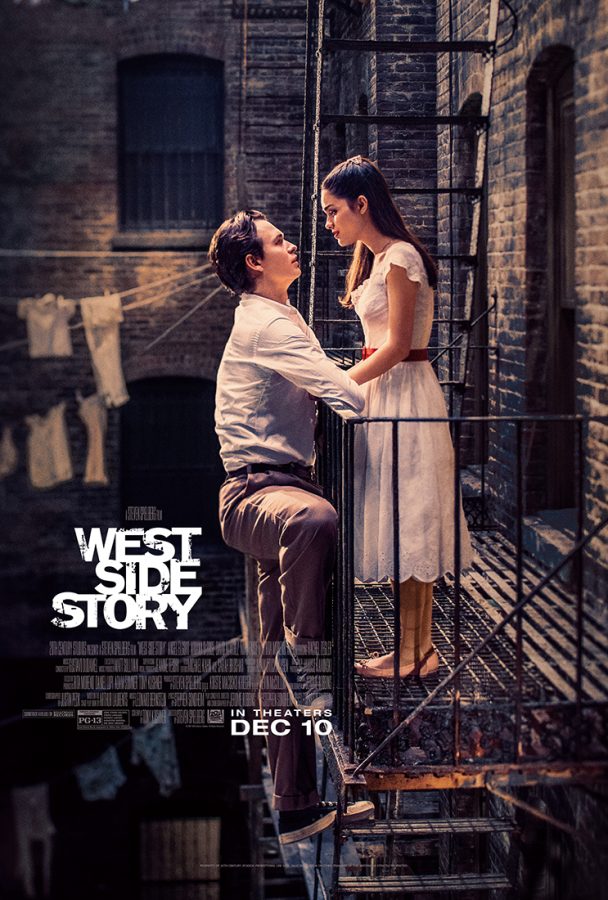A revamped West Side Story
Spielberg’s remake of the Romeo and Juliet reimagining includes necessary changes
Steven Spielberg’s 2021 remake of West Side Story was released on Dec. 10, 2021.
January 27, 2022
Sixty four years after the Broadway opening of West Side Story and 60 years after the first movie adaptation was released, Steven Spielberg’s “West Side Story” remake hit theaters on Dec. 10, 2021. Robert Wise and Jerome Robbins’ 1961 version was a tough act to follow, having won 10 Oscars, including Best Picture, so naturally, it was none other than 3-time Oscar award-winning director Steven Spielberg who was willing to take on the project.
“West Side Story” is a modern-day Romeo and Juliet, a story of young love entangled with violence, racism, crime and poverty, all tied together with traditional yet spirited Broadway-style musical numbers. It is the story of a gang rivalry between the Puerto Rican Sharks and the white Jets who are fighting for control of turf on New York City’s West Side amidst gentrification. When the Jets’ Tony (Ansel Elgort) and the Sharks’ Maria (Rachel Zegler) fall in love at a dance, the rivalry escalates into a deadly rumble.
Spielberg’s remake keeps most of the plot intact while reimagining the execution. With all new choreography, sets, cast, cinematography and costumes, it improves on many of the visual elements, along with some important cultural elements, while still staying true to the heart of the story. The remake reminds us of the relevancy of “West Side Story’s” central themes: the promise of the American Dream and its conflict with the unchanged reality of racism, the deep cultural divides that exist between us, and the bridges that can be built through optimism, hope and love. Despite all that has remained unchanged in the relevance of “West Side Story,” Spielberg made a few critical changes to the movie.
His casting choices were some of the most drastic, and most intelligent, changes he made. In the 1961 version, white actors played many of the Puerto Rican roles, including Natalie Wood as Maria. In the 2021 version, all of the Sharks are played by Hispanic, including mostly Puerto Rican, actors. Columbian newcomer Rachel Zegler put on a stunning performance as Maria, and Broadway star Ariana DeBose dominated her role as the first Afro-Latina to play Anita on screen. This increase in representation lent itself to the authenticity of the musical and to its central theme of the destructive, divisive nature of racism.
Spielberg got rid of Doc, the man who ran the corner store that both gangs went to, and replaced him with Valentina, Doc’s widow, who is played by the original Anita, Rita Moreno. Valentina continues Doc’s role as the bridge between the two gangs, as a Puerto Rican woman who was married to a white man, but with a new level of depth and meaning. In one of the most major soundtrack changes, Valentina sings “Somewhere,” which was sung as a duet by Maria and Tony in the original movie. When sung by Maria and Tony, the song is about their romantic desire to find a time and place where they can love each other in peace, but when sung by Valentina, the song is about the perpetual human desire to find “a new way of living,” where peace and love can conquer hatred and division.
The addition of Moreno is not the only change that added to the depth and complexity of the “West Side Story” remake. The underlying motives behind individual characters and the gangs as a whole was made much more clear.
With the Jets, the characters are more emotionally complex and have clearer motives. Jet leader Riff (Mike Faist), for example, is shown as more of a product of generational circumstances than just as a tough boy with a reputation to uphold; when he goes to buy a gun for the big rumble, the worker snarkily says that Riff looks like his deadbeat father. Tony’s background is also more developed. In the original, Tony is moving on from the Jets because he has a job and thinks he has outgrown the criminal behavior of his former gang. In the remake, Tony is fresh out of prison after almost murdering someone in a gang fight and is looking to change his ways. This new motivation brings desperation and a more intense character arc to Tony as he is dragged back into the gang by Riff despite working so hard to get out.
With the Sharks, the Puerto Ricans’ lives were far more developed and appreciated than in the original. They are fighting not just because of teenage angst or turf disagreements, but because they are being discriminated against and maligned by the Jets. In the opening number, the Jets vandalize a Puerto Rican flag, and the police show no desire to protect the Puerto Ricans. The addition of full Spanish dialogue between the Puerto Ricans — more than just the occasional Spanish phrase in the original — also adds a new layer of authenticity to the film. However, it is the choice to leave out subtitles that really shifted the depiction of the Sharks. Audience members who aren’t fluent in Spanish are able to easily tell what is being said through body language and other visual cues, but the omission of closed captions means that there is not a divide between the treatment of the Sharks’ and Jets’ scenes.
The gorgeous set design and costumes, wonderful casting choices and revamped cinematography all come together perfectly in the “America” number, which is one of the best numbers in the film. Though on the rooftop of Anita’s apartment in the original, Spielberg brings this classic song to the streets of New York City. DeBose, as Anita, reveals her expert dancing skills as she twirls in a yellow dress with a red underside that is revealed with every leg lift and flamenco foot stamp. Audiences are immersed in 1950’s West Side as 50s cars, costumes and hairstyles all come together to create a vision of a period piece made better by modern cinematography and flairs.
The “West Side Story” remake reminds us of all that has changed in America since the 1950s — and of how much has stayed the same. Though many questioned the need for a remake at first, Spielberg’s choices as director bring a new depth and relevance to the story.
4/5








